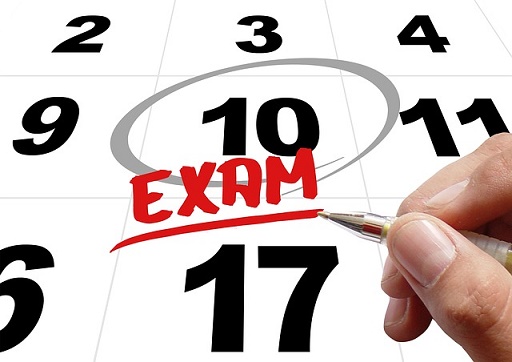
Not sure what to expect on GRE test day? What time should you arrive? What should you bring with you? What will it be like in the test center?
In this guide, we answer everything you need to know about the GRE test day. We’ll explain what you need to have ready before test day, how you should spend the morning before you leave for the test, how check-in will go at the test center, and last-minute GRE tips to keep in mind during the exam. When you know what to expect on the exam and the GRE test day tips you need to follow, you can stop worrying about test day and focus all your energy on doing well on the GRE.
What to Know Before GRE Test Day
Before you even wake up on your test day, there are some things you need to have already figured out, the most important of which are explained below.
Where the Test Center Is and How You’ll Get There
Well before test day, you absolutely need to know exactly where your test center is and how you’ll be getting there. Don’t rely on a vague idea of where the test center is, even if it’s in an area you know well. Most test centers are in nondescript office buildings with little or no signage to identify them. You want to make sure you have the exact address you need. Additionally, knowing the floor or room you need to go to will also be helpful, particularly if the test center is located within a large building.
You should also know how you’ll be getting to the test center. If another person will be driving you, confirm the plans with them the day before. If you’re taking public transportation, check online to make sure there hasn’t been any rerouting or closures due to construction or other issues.
Quick side note: we've created the world's leading online GRE prep program that adapts to you and your strengths and weaknesses. Not sure what to study? Confused by how to improve your score? We give you minute by minute guide.
You don't NEED a prep program to get a great GRE score. But we believe PrepScholar is the best GRE prep program available right now, especially if you find it hard to organize your study schedule and don't know what to study.
Click here to learn how you can improve your GRE score by 7 points, guaranteed.
The Correct Date and Time You Need to Be There
You may think you already know when your test is, but do yourself a favor and double check the date and time. It’s easy to do, and it can prevent a messy situation. Make sure you know the correct date you will be taking the GRE as well as when you are expected to arrive at the test center. You can find this information in your confirmation email. When deciding when you should leave for the test center, give yourself at least a 15-minute cushion to account for traffic and other unexpected events.
Which ID You’ll Be Bringing
If you don’t have proper ID, you won’t be able to take the GRE. You can read the complete ID guidelines here, but the key requirements are that the ID must:
- Be an original document (not a photocopy)
- Be valid and not past its expiration date
- Have your full name exactly as you entered it when you registered for the exam
- Include a recent, recognizable photograph
- Include your signature
Commonly accepted forms of ID include driver’s licenses, passports, and national IDs. Depending on which country you take the GRE in, there may also be additional ID requirements. You can check country-specific requirements by clicking the link above.
What Time You Need to Go to Sleep
The final thing you should do the night before your exam is get a good night’s sleep. This is not the time to do any last-minute studying. No cramming will help you as much as getting a full night’s sleep and waking up well-rested. Figure out what time you need to get to sleep, and stick to that schedule. Aim to get at least eight hours of sleep so you wake up refreshed and ready for the GRE.

What to Bring on GRE Test Day
Below is a list of everything you need to bring with you to have a successful and comfortable test day. At the end is also a note on several items you don’t need to worry about bringing to the GRE.
Your ID
The absolute most important thing to bring to the GRE test center is your ID. As mentioned above, you can’t take the GRE if you don’t bring an ID. Read the “Things to Have Ready Before GRE Test Day” section above for the complete ID requirements.
A Snack
The GRE is a long test, and it’s highly likely that, during the roughly four hours you’ll be in the testing center, you’ll get hungry. Taking the test on an empty stomach won’t do any favors for your score, so bring along a snack you can eat during the break. Something small and portable, like a granola bar or dried fruit and nuts is a solid choice.
A Water Bottle
In addition to food, you also want to make sure you’re well hydrated during the GRE. Most test centers will have drinking fountains, but bringing your own water bottle ensures you have guaranteed easy access to water.
A Sweater
Not all testing centers will be set at the perfect temperature for you, and if you’re thinking about how much you’re shivering or sweating, that can distract you from the test itself. Avoid this situation by bringing a sweater or hoodie with you to the test. Depending on the temperature, you can take it off or put it on to make sure you’re completely comfortable while you’re taking the test.
Your Confirmation Email/Authorization Voucher (If Applicable)
If you are taking the computer-based GRE (as most people do), you don’t need to worry about this, but if you are taking the paper-based GRE, you’ll need to bring a printed copy of your confirmation email (which you’ll receive after registering for a test) which will serve as your admission ticket.
What Not to Bring
There are several things you don’t need to worry about bringing to the GRE. These include pencils and scratch paper (you’ll be provided with these at the test center) as well as a calculator (there will be one on the computer for the Quantitative Reasoning section for computer-based exams and you’ll be given one for paper based exams.)
Also, this isn’t the time to wear your lucky necklace or any other jewelry (including watches). All jewelry, except for wedding and engagement rings are prohibited in the test center, so if you’re wearing any, you’ll need to remove them before you can start the GRE.

What to Do the Morning of Your GRE Test
Below are some last-minute GRE tips to keep in mind before you leave for the testing center.
Get Up on Time
Start your day off right by getting up on time. The night before, set your alarm so that you have plenty of time to get ready and get to the test center on time. (This is especially important if you have a morning exam.) If you’re a fan of hitting the snooze button, be sure to account for that as well when deciding when to set your alarm.
Eat a Healthy Breakfast
One of the best things you can do the morning of your exam is to eat a good breakfast. You want to eat a meal that will keep you full for several hours while you take the test, so don’t choose anything made entirely of simple carbs and sugar. Protein and healthy fats are your friends. You can Google “healthy breakfasts,” or use one of the ideas below:
- Eggs (scrambled, omelette, etc.)
- Whole grain toast topped with peanut butter or avocado
- Fruit smoothie (possibly with protein powder added)
- Oatmeal with fruits and nuts
Schedule Extra Time to Get to the Test Center
It’s very important to leave on time to ensure you get to the test center at the correct time. At least the day before the GRE, you should know what time you need to leave to get to the test center. If you arrive late, you may not be allowed to take the GRE, and you’ll lose your registration fee.
You should arrive at the test center at least 30 minutes before your scheduled testing time. Be sure to leave yourself a buffer to account for traffic, taking a wrong turn, or other things that could delay your arrival at the testing center.
Make Sure You Have Everything You Need
Before you leave, double-check that you have everything you need with you for the GRE, especially your ID. Check the previous section to make sure you haven’t forgotten anything. It can help to group all the items you need together on a table or desk the night before so you’re not hunting around for them on the morning of your test.
Want to improve your GRE score by 7 points? We have the industry's leading GRE prep program. Built by world-class instructors with 99th percentile GRE scores, the program learns your strengths and weaknesses through machine learning data science, then customizes your prep program to you so you get the most effective prep possible.
Try our 5-day full access trial for free:

What to Expect at the GRE Test Center
You got a good night’s sleep, brought everything you need, and have now arrived at the test center. What happens now? Below we’ll walk you through a typical GRE test day so that you know exactly what to expect. These steps assume you’re taking the computer-based GRE since the vast majority of people take that version of the exam.
#1: Signing In
When you arrive at the test center (about 30 minutes before your GRE is scheduled to start), there will be a person there to check you in. You’ll need to show your ID, and you may also be required to verify your ID. If and how this is done depends on the individual test center, but common examples include having your picture taken, using signature comparison, and/or being fingerprinted. If you have a confirmation email/voucher you’ll also need to show it at this time.
#2: Storing Personal Belongings
After your ID has been confirmed, you’ll need to put all your personal items in a locker. This includes all electronic devices (including phones), jewelry, watches, notes, food, drinks, and jackets or other outerwear. You’ll also likely have to turn out your pockets to show they’re empty. Basically, you can’t bring any of your own belongings into the test center with you except for a light clothing layer, such as a sweatshirt or sweater, so that you’ll be at a comfortable temperature during the test.
You won’t be able to access these items during the GRE, except for drinks, food, and medication (if you brought any) which you can access only during the exam break.
#3: Completing the Confidentiality Statement
Next, you’ll need to write and sign a confidentiality statement signifying that you won’t tell others the questions you were asked on the exam. Now is a good time to ask the proctor any questions you might have.
#4: Beginning the Test
The proctor will then give you scratch paper and pencils and assign you to a computer in the testing room. There will likely already be other students there who are also taking an exam, which may be the GRE or another test. Everyone will be at a different spot in the exam; you won’t all be taking it together.
Once seated at your computer, you’ll have the option to complete a tutorial, which will walk you through basic computer functions, such as how to scroll and go back and forth between questions. You probably already know how to do all this, but it’s usually a good idea to run through the tutorial anyway, especially if you’re feeling nervous. After the tutorial, you’ll have the option to choose up to four schools to send your scores to. This doesn’t automatically send your scores to them though; that happens after you finish the exam, and we’ll explain that more in a few steps.
#5: Taking the Test
Now you’re ready to start your test! The GRE lasts about 3 hours and 45 minutes from start to finish. The first section will always be Analytical Writing, where you’ll write two essays (30 minutes are given for each). This will be followed by five Quantitative Reasoning and Verbal Reasoning sections (including one unscored experimental section, although you won’t know which section this is.)
After you complete your third section (so about halfway through the exam), you’ll have a ten-minute break. This is when you can leave the testing room, use the bathroom, and eat your snack. You’ll need to sign out on a form the proctor gives you when you leave the room and sign back in when you reenter. You’ll likely have to again show your pockets are empty and that you don’t have any prohibited materials on you before being allowed back in the testing room.
After the ten-minute break, there will be a one-minute break between each of the remaining sections. All of these breaks are optional (though recommended), and you can always choose to skip them and keep going with the test.
And that’s the GRE! For every step there are clear instructions to follow so you know what to expect. If you have a question or a problem during the exam, raise your hand, and the proctor will come in and assist you.
#6: Seeing and Sending Scores
After you’ve finished the exam (yay!), you’ll immediately be able to see your unofficial scores for Verbal Reasoning and Quantitative Reasoning. These scores will likely be the same as the official scores you receive several weeks later. After viewing your scores, you then get to decide whether you want those scores sent to the schools you indicated earlier.

The 3 Most Important GRE Test Day Tips
You’re now an expert on what to expect during the GRE, and below are three final GRE test day tips to ensure you’re completely prepared for anything thrown your way.
Keep Calm
The GRE is an important test, and it can be easy to get nervous and stressed while you’re taking it. However, staying calm and focused during the exam is an important part of scoring well. Nerves can cause you to make silly mistakes on the exam which can lower your score.
If you begin to feel nervous during the test, pause for ten seconds and take a few deep breaths. Remind yourself that, even if you have no idea how to answer a particular problem, it’s OK not to know every answer, and you can just skip it and come back to it. Also, if you’re unhappy with your score, you can always take the GRE again. If you already know that you’re prone to test anxiety, feeling prepared can help alleviate anxiety. Take realistic practice tests well before exam day so that you know exactly what to expect on the test.
Answer Every Question
There is no penalty for incorrect questions on the GRE, so you should be sure to answer every question to maximize your chances of getting the best score possible. It’s fine to skip a question the first time you see it if you’re not sure what the correct answer is, but aim to leave at least two minutes at the end of every section to go back and answer any questions you skipped. Even a random guess is better than no answer.
Pay Attention to the Time
Good time management is key for doing well on the GRE. At the beginning of every section, you’ll see how much time you have to complete it, and during the section there will be a timer in the corner of the computer screen. Don’t lose track of time! Spending several minutes on one question could cause you to run out of time and before completing the section, and that can really hurt your score.
Keep an eye on the time during the exam and, if you’ve spent a minute on a question and still have no idea how to solve it, skip it and come back to it once you’ve gone through all the other questions.
Conclusion
Knowing what to expect on GRE test day can help you feel more prepared and confident going into the test. There are certain steps you should take before test day, the morning of test day, and when arriving at the test center, as well as last-minute GRE tips that are useful to keep in mind while you’re taking the test.
When you know how the day will go and what you’ll need to do, you can focus all your energy on getting a top score!
Want to improve your GRE score by 7+ points?
Check out our best-in-class online GRE prep program. We guarantee your money back if you don't improve your GRE score by 7 points or more.
PrepScholar GRE is entirely online, and it customizes your prep program to your strengths and weaknesses. We also feature 2,000 practice questions, official practice tests, 150 hours of interactive lessons, and 1-on-1 scoring and feedback on your AWA essays.
Check out our 5-day free trial now:
What’s Next?
What GRE score should you be aiming for when you take the exam? Learn what a good GRE score is based on the schools you’re interested in.
Want to maximize the score you get on the GRE? Check out our ultimate study guide for the GRE so you can get your best score!
Not sure if you’re preparing enough for the GRE? Learn how hard the test really is and get an estimate of how challenging it’ll be for you.
Ready to improve your GRE score by 7 points?
We've written a eBook about the top 5 strategies you must be using to have a shot at improving your GRE score.
Download it for free now:

